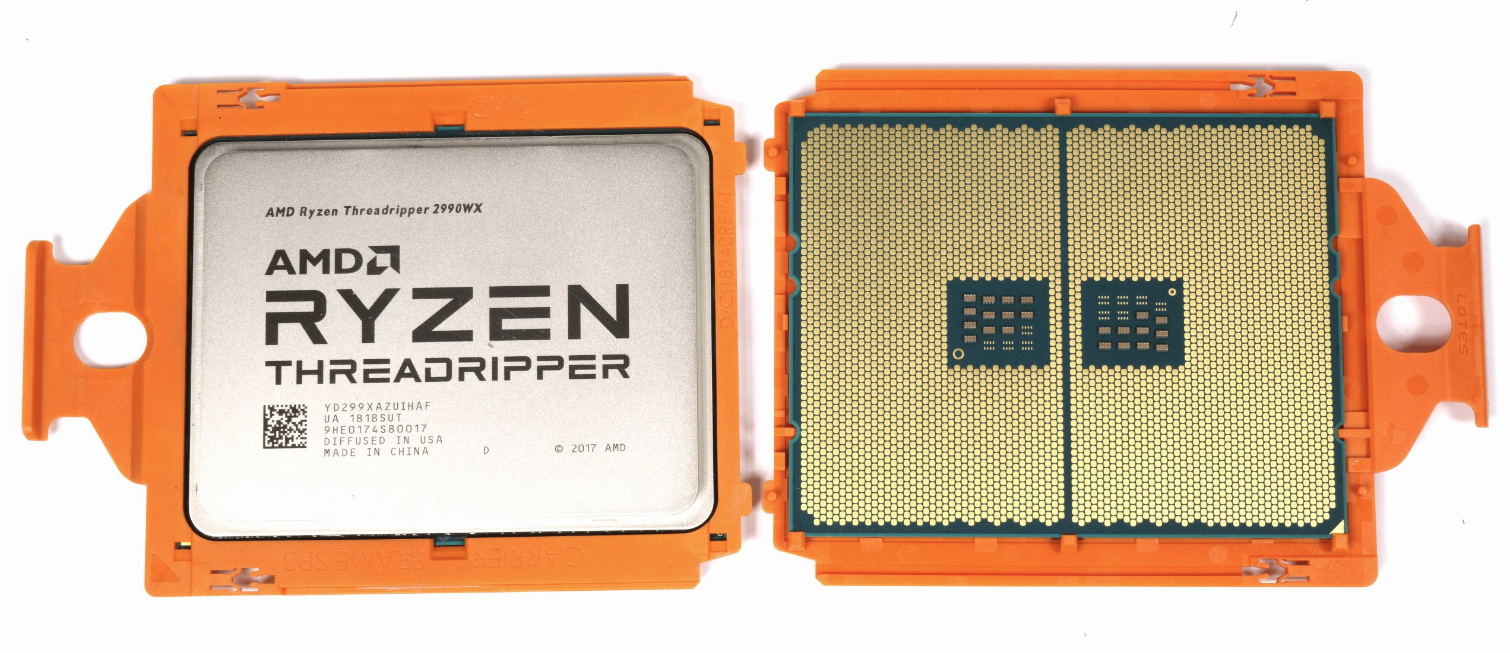Ryzen Threadripper 2 (2990WX and 2950X) Review: AMD Unleashes 32 Cores
Why you can trust Tom's Hardware
Final Analysis
Ryzen Threadripper 2990WX continues AMD's assault on Intel's market dominance with 32 cores and the ability to work on 64 threads concurrently. But AMD's new flagship has its issues, too. There's no denying the allure of such a powerful processor. But as we've seen from other high-core-count CPUs, power delivery and thermals can conspire to hinder performance.
While drop-in compatibility with existing X399 motherboards is a big selling point favoring AMD, not every board's power delivery subsystem is up to the job of facilitating maximum performance from the 2990WX (particularly if you plan to overclock). You really need a high-end motherboard, a high-end power supply, and high-end cooling to extract the utmost performance from your investment.
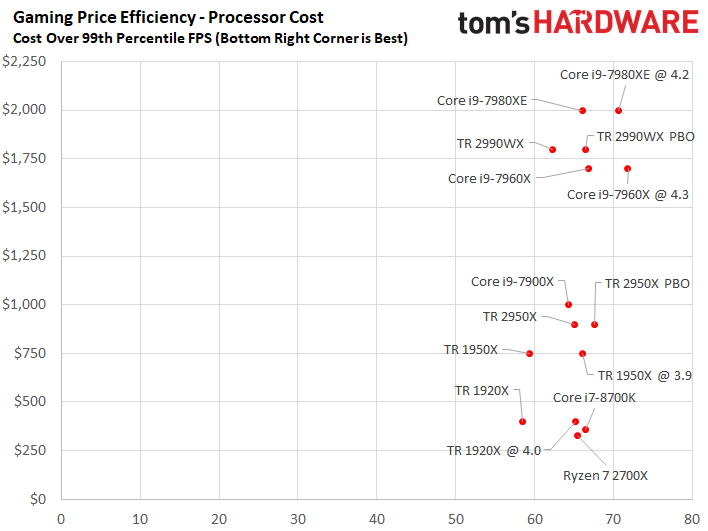
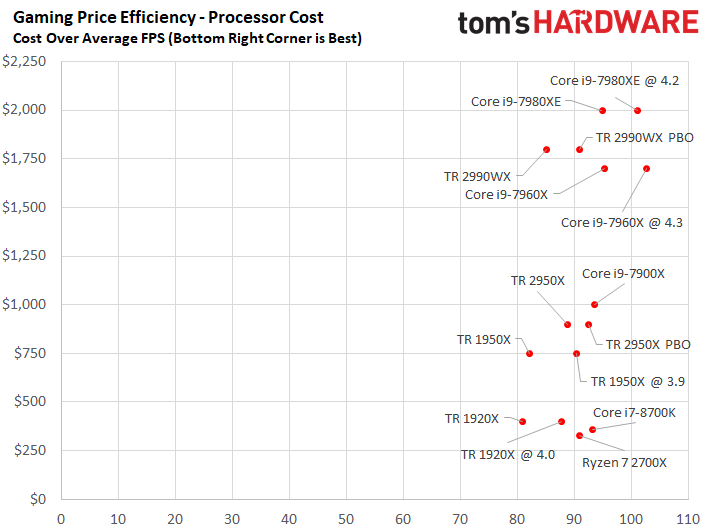
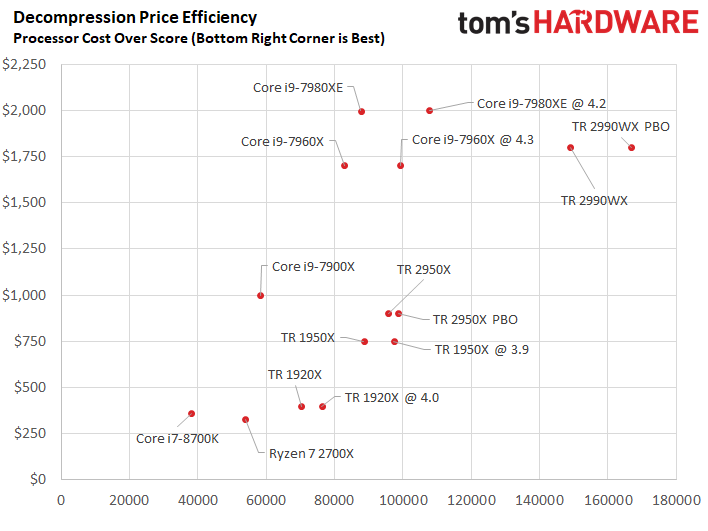
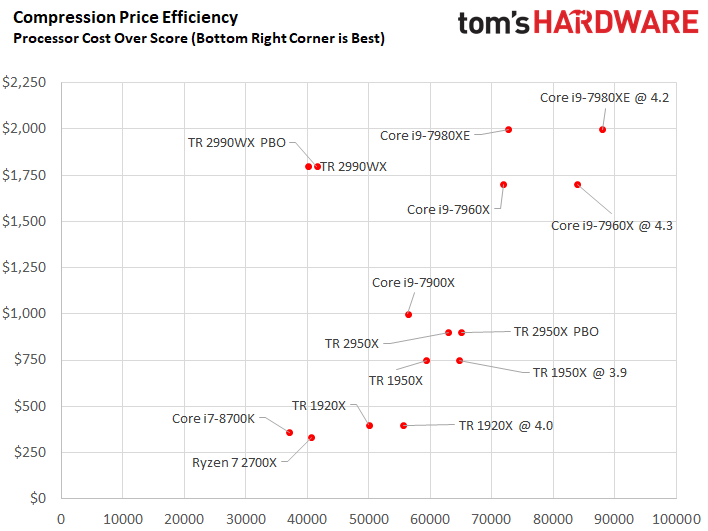
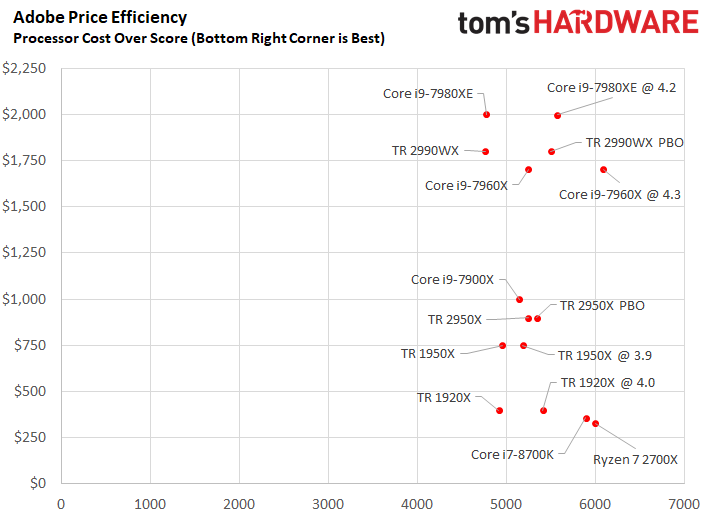

Ryzen Threadripper 2990WX is nothing short of phenomenal in workloads that can utilize its arsenal of execution cores. Rendering is a good example. But it doesn't scale well in other applications. The distributed architecture leaves half of the processor's compute resources stranded from the memory and I/O controllers, which can drastically reduce performance in applications sensitive to bandwidth or PCIe traffic. Unless you have a very specific workload that can't get enough parallelism, you're better off with Threadripper 2950X.
Threadripper 2950X is much more appealing to the enthusiast audience. Its dual-die design once seemed exotic, but now proves nimble in a wide variety of applications. Moreover, higher Precision Boost frequencies make the 2950X competitive against well-established Intel Core processors in lightly-threaded metrics.
Precision Boost Overdrive offers an easy path to overclocking both new Threadrippers if your supporting hardware can handle the stress. Just be aware that any gains you might see vary based on your system's capabilities. We're sure we can tease even more performance out via manual overclocking when we circle back for the dedicated review, but the automated overclocking feature is plenty capable for most users, and you retain the benefit of a beastly 4.4 GHz quad-core boost frequency. The Threadripper 2950X brings a lot more power for a lower price than the first-gen Threadripper did at launch, but we wouldn't recommend a direct upgrade from the 1950X. If you're looking to upgrade from an older CPU to an all-around crowd pleaser, Threadripper 2950X does not disappoint.
Considering the raw horsepower on offer, AMD's pricing is extremely competitive. Ryzen Threadripper 2950X kept pace with the $1700 Core i9-7960X in many of our tests, but sells for almost half of its price. Both Intel and AMD HEDT platforms are expensive, but X399 motherboards are particularly pricey, which you'll have to consider when weighing your options. Populating all four memory channels will also be expensive in these trying times, but that extra cost applies to both high end platforms.
While we still recommend the mainstream Ryzen 7 2700X or Core i7-8700K for gaming, they clearly can't keep pace with Threadripper in productivity-oriented applications. Intel's Skylake-X processors are still brutally competitive on the performance front, but the company needs to be adjust its pricing.
Get Tom's Hardware's best news and in-depth reviews, straight to your inbox.
If you're after the utmost in threaded performance for the dollar, the Ryzen Threadripper 2 series delivers. AMD clearly takes the lead with the most raw computing power on the desktop PC market, and at ultra-competitive pricing. We can't wait to see Intel's response.
MORE: Best CPUs
MORE: Intel & AMD Processor Hierarchy
MORE: All CPUs Content

Paul Alcorn is the Editor-in-Chief for Tom's Hardware US. He also writes news and reviews on CPUs, storage, and enterprise hardware.
-
Rdslw first table is broken 32/64 cores/threads :)Reply
Ryzen Threadripper 2990WX
Ryzen Threadripper 2950X
Socket
TR4
TR4
Cores / Threads
16 / 32
16 / 32 -
philipemaciel Wow, while the 2990WX is a bit of a letdown, the 2950X is a nice surprise. Plenty of bang for your buck!Reply -
alves.mvc Why does Tom's Hardware stopped using the HPC benchmark? It was the most interesting measurement for me that work daily with finite differences and finite elements. Can you return to that?Reply -
totaldarknessincar Seems to me the best of both worlds continue to be Intel's 7900x which sells for $699 at microcenter. You get great gaming performance, and great multithreaded performance, and it's not 12-1800 bucks as some of these mega-threaded cards are.Reply
Despite all the fan-fare, it seems the 7980xe actually remains the best processor when overclocked overall.
Lastly for gaming, it's still 8700K or 8086 as best, with the 2700x from AMD being the best when you factor gaming and some multi-threaded stuff, while being very competitive price wise. -
feelinfroggy777 Very surprising performance from the 2950x. Almost enough to consider parting ways with my 1950x. Maybe when the pricing comes down some from the 2950x in a few months I will consider.Reply
The 2990wx on the other hand is a slight let down. Too bad they could not get the scaling down between the dies like they did with Threadripper 1. But I have read that was going to be an issue. Maybe AMD did not want the 2990wx to cannibalize their Epyc market.
With that being said, the 2990wx is still a modern marvel of technology, even more so when you consider the price. Only couple of years ago a CPU with less than a third of the cores cost just as much.
Competition sure is grand! -
basil.thomas Looks like Intel has an opportunity to bite AMD when they release their 28-core processor. I have a threadripper 2/x399 system but if I upgrade to the 2990wx, I will also upgrade the motherboard and the power supply as well. I think I may wait until the Intel 28 core comes out and see what kind of performance it delivers as I too notice running custom AI apps on the threadripper is barely faster than my old x99/6850 motherboard overclocked @ 4.3Ghz. I want max performance if I am going to pay over $1800 for the flagship which means core wars is just starting...Reply
MOD EDIT: watch your profanity -
ffleader1 Reply
Seem to me that you are mistaking best of both work with jack of all trade. No one who takes rendering seriously would want to sacrifice the performance for gaming. For that price, they may as well grab a 1950X. Sure you lose in gaming, but gain a huge jump in rendering. Also, I don't know about Microcenterbut it's still 1k on Amazon while 1950X is $850. 7900X is like a really really bad choice lol.21228046 said:Seems to me the best of both worlds continue to be Intel's 7900x which sells for $699 at microcenter. You get great gaming performance, and great multithreaded performance, and it's not 12-1800 bucks as some of these mega-threaded cards are.
Despite all the fan-fare, it seems the 7980xe actually remains the best processor when overclocked overall.
Lastly for gaming, it's still 8700K or 8086 as best, with the 2700x from AMD being the best when you factor gaming and some multi-threaded stuff, while being very competitive price wise.
